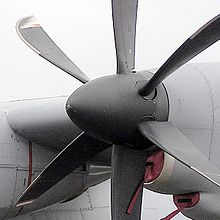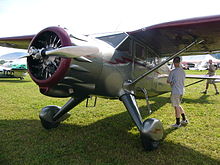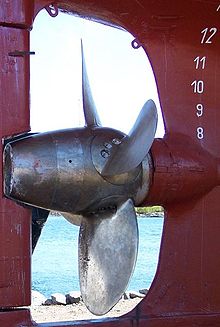- Controllable pitch propeller
-
A controllable pitch propeller (CPP) or variable pitch propeller is a type of propeller with blades that can be rotated around their long axis to change their pitch. If the pitch can be set to negative values, the reversible propeller can also create reverse thrust for braking or going backwards without the need of changing the direction of shaft revolutions.
Contents
Aircraft
 One of a C-130J Super Hercules' four Dowty Rotol controllable and reversible pitch propellers.
One of a C-130J Super Hercules' four Dowty Rotol controllable and reversible pitch propellers. A Hamilton Standard variable pitch propeller on a 1943 model Stinson V77 Reliant
A Hamilton Standard variable pitch propeller on a 1943 model Stinson V77 Reliant
The earliest known attempt towards creating a variable-pitch propeller of any type for an aircraft, though only adjustable on the ground before or after flight, was on the IdFlieg-numbered "R.30/16" example of the Zeppelin-Staaken R.VI four-engined World War I-era Riesenflugzeug heavy bomber in 1918.
The French aircraft firm Levasseur displayed a variable pitch propeller at the 1921 Paris Airshow which it claimed had been tested by the French government in a ten-hour run and could change pitch at any engine rpm.[1]
Dr Henry Selby Hele-Shaw and T E Beacham patented an hydraulically-operated variable-pitch propeller (based on a variable stroke pump) in 1924 and presented a paper on the subject before the Royal Aeronautical Society in 1928, though it was received with scepticism as to its utility.[2] The propeller had been developed with Gloster - as the "Gloster Hele-Shaw Beachem" - and was demonstrated on a Gloster Grebe where it was used to maintain a near-constant rpm.[3]
The first practical controllable pitch propeller for aircraft was introduced in 1932.[4]
Such propellers are used in propeller-driven aircraft to adapt the propeller to different thrust levels and air speeds so that the propeller blades don't stall, hence degrading the propulsion system's efficiency. Especially for cruising, the engine can operate in its most economical range of rotational speeds. With the exception of going into reverse for braking after touch-down, the pitch is usually controlled automatically without the pilot's intervention. A propeller with a controller that adjusts the blades' pitch so that the rotational speed always stays the same is called a constant speed propeller. A propeller with controllable pitch can have a nearly constant efficiency over a range of airspeeds.[5]
The most common type of controllable pitch propeller is hydraulically actuated; it was originally developed by Frank W. Caldwell of the Hamilton Standard Division of the United Aircraft Company. This design led to the award of the Collier Trophy of 1933.[1] de Havilland subsequently bought up the rights to produce Hamilton propellers in the UK, while the British company Rotol was formed to produce its own designs. The French company of Pierre Levasseur and the US Smith Engineering Co. also developed controllable pitch propellors. Smith propellers were used by Wiley Post on some of his flights.
As experimental aircraft and microlights have become more sophisticated, it has become more common for such light aeroplanes to fit variable-pitch propellers, both ground-adjustable propellers and in-flight-variable propellers. Hydraulic operation is too expensive and bulky, and instead light aircraft use propellers that are activated mechanically or electrically. Some are manually operated, some are controlled by electronics; and one, the "Silence V-Prop",[6] is fully self-powering and self-adjusting.
Ships
Controllable pitch propellers (CPP) for marine propulsion systems have been designed to give the highest propulsive efficiency over a broad range of speeds and load conditions. When the vessel is fully loaded with cargo the propulsion required at a given ship speed is much higher than when the vessel is empty. By adjusting the blade pitch, the optimum efficiency can be obtained and fuel can be saved. Also, the controllable pitch propeller has a "vane"-stance, which is useful with combined sailing / motor vessels as this stance gives the least water resistance when not using the propeller (e.g. when the sails are used instead).
A fixed pitch propeller (FPP) is more efficient than a controllable pitch propeller under a specific rotational speed and load condition. At that particular rotational speed and load, a FPP can transmit power more efficiently than a CPP. At any other rotational speed, or any other vessel loading, the FPP will not be more efficient, either being over pitched or under pitched. A correctly sized controllable pitch propeller can be efficient for a wide range of rotational speeds, since pitch can be adjusted to absorb all the power that the engine is capable of producing at nearly any rotational speed.
The CPP also improves maneuverability of a vessel. When maneuvering the vessel the advantage of the CPP is the fast change of propulsion direction. The direction of thrust can be changed without slowing down the propeller and depending on the size of the CPP can be changed in approximately 15 to 40 seconds. The increased maneuverability can eliminate the need for docking tugs while berthing.
A reversing gear or a reversible engine is not necessary for ships utilizing CPP, saving money to install and service these components. Depending on the main engine rotational speed and the size of the CPP, a reduction gear may still be required. A CPP does require a hydraulic system to control the position of the blades. A CPP does not produce more or less wear or stress on the propeller shaft or propulsion engine than an FPP. Therefore this will not be an argument to choose between an FPP or a CPP.
Large vessels that make long trips at a constant service speed, for example crude oil tankers or the largest container ships, do not utilize a CPP, since the amount of power generated exceeds the current CPP design capabilities. A CPP is usually found on harbor or ocean-going tugs, dredgers, cruise ships, ferries, cargo vessels and larger fishing vessels that sail to ports with limited or no tug assistance. Prior to the development of CPPs, some vessels would alternate between "speed wheel" and "power wheel" propellers depending on the task.
Current CPP designs can tolerate a maximum output of 44000 kW (60,000 hp).
Bruntons, an engineering firm in Essex, has patented the "AutoProp", a marine propeller where the blades swivel freely and automatically set to the correct angle. The Autoprop is suitable for small to medium yachts and boats, and is particularly beneficial for motor-sailers. [7]
References
- ^ "Pierre Levasseur Flight, November 17th 1921, see last paragraph on page 761
- ^ Aircraft gear box Flight August 14, 1941 p86
- ^ Flight October 11, 1928 p14-15
- ^ "Gear Shift For Airplanes Seen In Controllable Prop" Popular Mechanics, December 1932
- ^ Lutze. Level flight performance page 8 The Department of Aerospace and Ocean Engineering, Virginia Tech. Accessed: 6 January 2011.
- ^ http://www.silence-twister.co.uk/silence%20twister%20propeller.htm
- ^ http://www.bruntons-propellers.com/Autoprop/Autoprophome.htm
External links
- 1941 Cutaway Drawing of Hydromatic Variable Pitch Propeller Operation on B-24 bomber
- Contemporary discussion of merits of variable pitch propellers in Flight magazine 1935
- CONTROLLABLE-PITCH AIRSCREWS explained in Flight 2 May 1935 and 9 May 1935
Aircraft gas turbine engine components, systems and terminology Gas turbines TypesPropfan · Turbofan · Turbojet · Turboprop · Turboshaft
Mechanical
componentsAfterburner (reheat) · Axial compressor · Centrifugal compressor · Combustor · Constant Speed Drive · Propelling nozzle · Turbine blade
TerminologyPropellers ComponentsTerminologyAutofeather · Blade pitch · Contra-rotating · Constant speed · Counter-rotating · Proprotor · Scimitar propeller · Variable pitch
Engine
instrumentsAnnunciator panel · Electronic Centralised Aircraft Monitor (ECAM) · Electronic Flight Instrument System (EFIS) · Engine Indicating and Crew Alerting System (EICAS) · Flight data recorder · Glass cockpit
Engine controls Autothrottle · Full Authority Digital Engine/Electronics (FADEC) · Thrust lever · Thrust reversal
Fuel and induction
systemsOther systems Air-start system · Auxiliary power unit (APU) · Bleed air system · Hydraulic system · Ice protection system
Categories:- Propellers
- Ship construction
Wikimedia Foundation. 2010.


